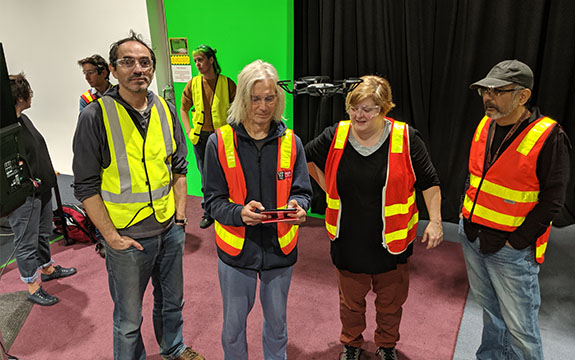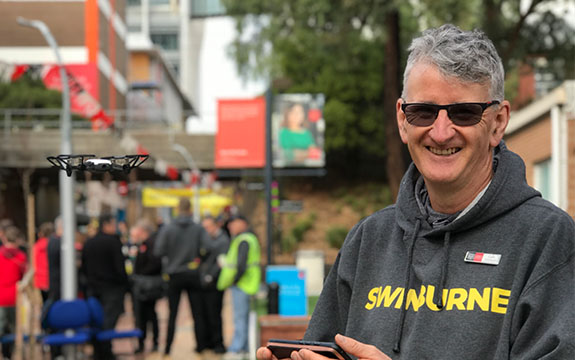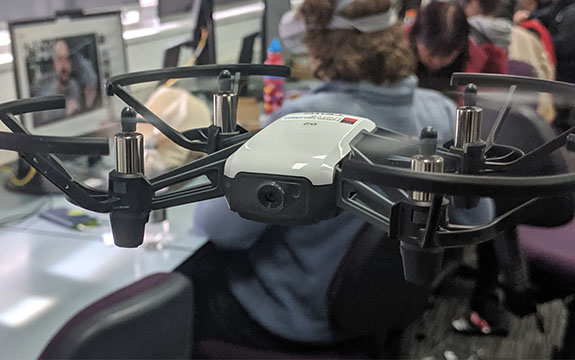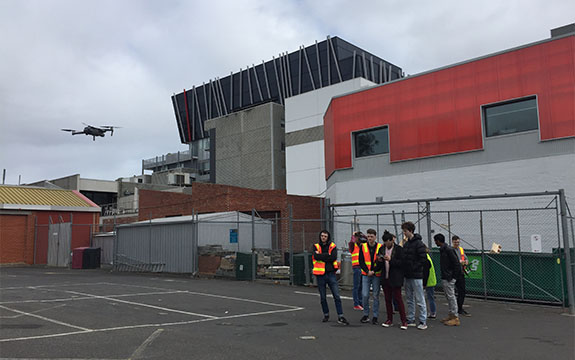Swinburne drone teaching methods taking off

In Summary
- Swinburne is incorporating drones into lesson plans across four Pathways and Vocational Education (PAVE) courses
- Students are learning how to pilot a drone, drone safety rules, technical knowledge, and other new skills to equip them for future careers
Pathways and Vocational Education (PAVE) Project Officer, Cam Gleeson, is part of a team incorporating drones into lesson plans across four courses at Swinburne’s Hawthorn, Croydon and Wantirna campuses.

Cam Gleeson started with PAVE as a plumbing teacher and now spearheads the use of drones in lessons
This "off-the-ground" method of teaching is helping students learn new skills across vocational and tertiary courses including building, construction, engineering, health and community science, design media and information communication technology.
Mr Gleeson is part of the Transforming Learning team, who have a mission to transform teaching practices across Swinburne PAVE by inspiring and empowering staff to develop capacity and capability in innovative teaching and learning methods.
Incorporating drones into the lesson plan
"Drones are enhancing traditional lessons with exciting and innovative new ways of teaching," Mr Gleeson says.
"We work with teachers and co-ordinators to devise ways they can incorporate mixed technology, particularly drones, into the classroom. Mixed reality is a key component in the PAVE course review and transformation process, which is currently being rolled out across all departments.
"We are always adapting our teaching to suit the ever-changing landscape of society, economy, education and technology. We always ask ourselves 'how do we take a course that has been running for 30 years and get drones to improve the learning for a student?'"
Equipping Swinburne students for the future

Teachers and coordinators learn the drone basics and receive full support and encouragement to borrow the drones and lead their own sessions.
PAVE’s 10 mini drones and one high-definition larger drone have been introduced into the classroom as a teaching tool via a three-hour program.
The program includes Civil Aviation Safety Authority (CASA) regulations and technical operating procedures.
PAVE’s Transforming Learning Executive Manager, Diana Swift, says the use of drones in commercial applications is now commonplace and will continue to grow rapidly.
"Drones are regularly used in many fields including photography, emergency services, sport and real estate. It’s essential our students have experience with drones as preparation for their chosen vocation," Ms Swift says.
Drone increasing worksite safety
Mr Gleeson says drones can potentially improve safety in a wide range of industries, and PAVE trade students are learning first hand how drones are making construction sites safer.
"From the ground, a person can control a drone and send it up to survey a multi-story building, provide an aerial view of a worksite, inspect hard to reach or high-risk areas and ultimately determine if an environment is safe for a worker," Mr Gleeson says.
"Drones can be an eye in the sky and save a person from having to work at heights or in a confined space. They can essentially save lives because it minimises the risk of slips, trips and falls."
Using a drone to make film and television
Mr Gleeson says drones can also record footage and relay it back to stakeholders, which is changing the nature of filmmaking.

Swinburne film and television students practice flying drones and recording footage
Mr Gleeson recently ran a workshop for Diploma of Screen and Media – Film and Television students to allow them to see how drones could be a low-cost solution to expensive aerial cinematography.
"We worked with the course coordinators beforehand to ensure we would teach the students more than how to fly a drone or press record,"
"Over 20 students were learning safety and operational procedures firstly, and how drones can be used in all stages of production for film and TV – basically how to tell a story with a flying camera."

